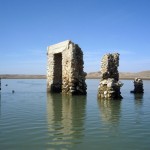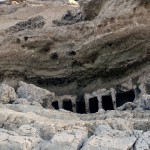 Iraq is suffering the worst drought in decades, and as the waters of the Euphrates recede, ancient ruins are surfacing for the first time since Saddam Hussein dammed the area in the mid-1980’s.
Iraq is suffering the worst drought in decades, and as the waters of the Euphrates recede, ancient ruins are surfacing for the first time since Saddam Hussein dammed the area in the mid-1980’s.
Ratib says that at least 75 archeological sites had been partially excavated before the area was flooded. They ran the gamut of civilizations — from 3,000 B.C. to the Sumerian and Roman periods. Ancient Jewish settlements were also submerged in the area. But because of the receding waters, Ratib has been able to access some sites for the first time — including, for instance, a cliff with a series of pre-Christian tombs carved into its face. Though they have been heavily damaged by the water, Ratib says they still have value. […]
But it’s not only previously discovered archaeological sites that the drought has made accessible.
Ratib and a colleague are suddenly excited by something they’ve seen on this particular day. They kneel next to what looks like an old stone wall, shards of pottery everywhere. Ratib says he believes it is a Roman-era irrigation ditch.
“I’ve never seen this site before,” he says. “When we excavated this area decades ago, this was all buried underneath the soil, but the receding waters uncovered it.”
 Unfortunately, these discoveries come at the expense of local farmers and fisherman, who deprived of their normal income, have a strong incentive to loot the newly reveled sites.
Unfortunately, these discoveries come at the expense of local farmers and fisherman, who deprived of their normal income, have a strong incentive to loot the newly reveled sites.
It’s unlikely that Baghdad will be able to finance reasonable protection of the sites, never mind further excavations. There are 10, count them, 10 guards assigned to protect the entire Anbar province. This does not bode well.